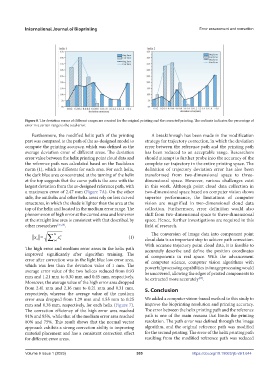Page 313 - IJB-9-1
P. 313
International Journal of Bioprinting Error assessment and correction
Figure 8. The deviation errors of different ranges are counted for the original printing and the corrected printing. The ordinate indicates the percentage of
error in a certain range to the total error.
Furthermore, the modified helix path of the printing A breakthrough has been made in the modification
part was compared to the path of the as-designed model to strategy for trajectory correction, in which the deviation
compute the printing accuracy, which was defined as the error between the reference path and the printing path
average deviation error of different areas. The deviation has been reduced to an acceptable range. Researchers
error value between the helix printing point cloud data and should attempt to further probe into the accuracy of the
the reference path was calculated based on the Euclidean complete ear trajectory in the entire printing space. The
norm (1), which is different for each area. For each helix, definition of trajectory deviation error has also been
the dark blue area concentrated at the turning of the helix transformed from two-dimensional space to three-
at the top suggests that the curve path is the area with the dimensional space. However, various challenges exist
largest deviation from the as-designed reference path, with in this work. Although point cloud data collection in
a maximum error of 2.47 mm (Figure 7A). On the other two-dimensional space based on computer vision shows
side, the antihelix and other helix areas rely on less curved superior performance, the limitations of computer
structures, in which the shade is lighter than the area at the vision are magnified in two-dimensional cloud data
top of the helix and located in the medium error range. The collection. Furthermore, error definition would also
phenomenon of high error at the curved area and low error shift from two-dimensional space to three-dimensional
at the straight line area is consistent with that described by space. Hence, further investigations are required in this
other researchers [25,38] . field of research.
x = ∑ N x (1) The conversion of image data into component point
2
2 i 1 = i cloud data is an important step to achieve path correction.
With accurate trajectory point cloud data, it is feasible to
The high error and medium error areas in the helix path accurately describe and define the position coordinates
improved significantly after algorithm training. The of components in real space. With the advancement
error after correction was in the light blue low error area, of computer science, computer vision algorithms with
which was less than the deviation value of 1 mm. The powerful processing capabilities in image processing would
average error value of the two helices reduced from 0.93 be uncovered, allowing the edges of printed components to
mm and 1.21 mm to 0.30 mm and 0.45 mm, respectively. be extracted more accurately .
[39]
Moreover, the average value of the high error area dropped
from 2.41 mm and 2.16 mm to 0.21 mm and 0.31 mm, 5. Conclusion
respectively, whereas the average value of the medium
error area dropped from 1.29 mm and 1.55 mm to 0.25 We added a computer vision-based method to this study to
mm and 0.38 mm, respectively, for each helix (Figure 7). improve the bioprinting resolution and printing accuracy.
The correction efficiency of the high error area reached The error between the helix printing path and the reference
91% and 85%, while that of the medium error area reached path is one of the main reasons that limits the printing
80% and 75%. This result shows that the normal vector resolution. The path error was defined through the image
approach exhibits a strong correction ability in improving algorithm, and the original reference path was modified
material placement and has a consistent correction effect for the second printing. The error of the helix printing path
for different error areas. resulting from the modified reference path was reduced
Volume 9 Issue 1 (2023)olume 9 Issue 1 (2023)
V 305 https://doi.org/10.18063/ijb.v9i1.644

